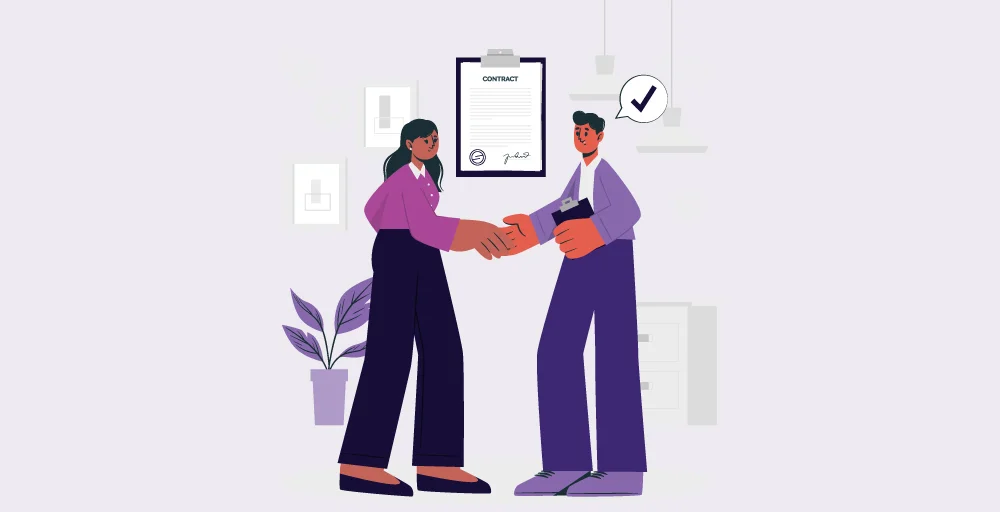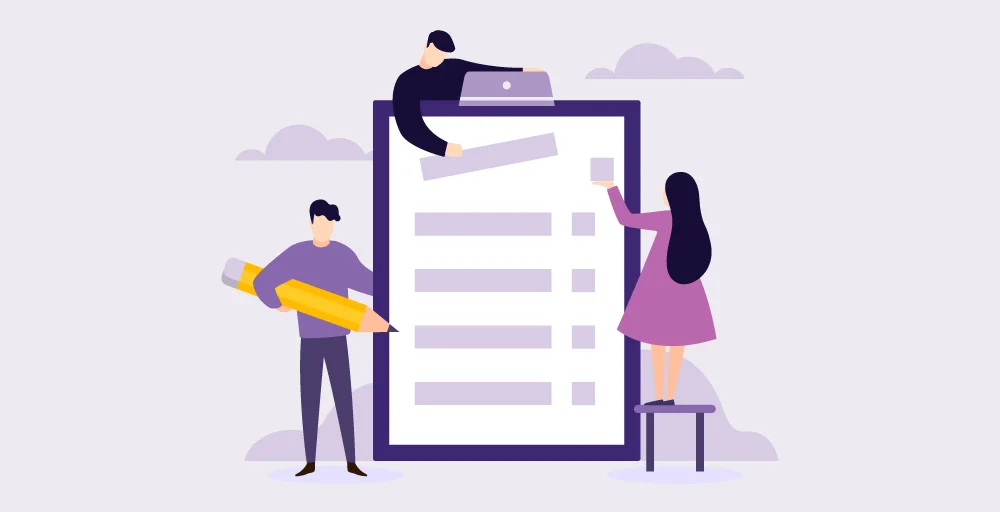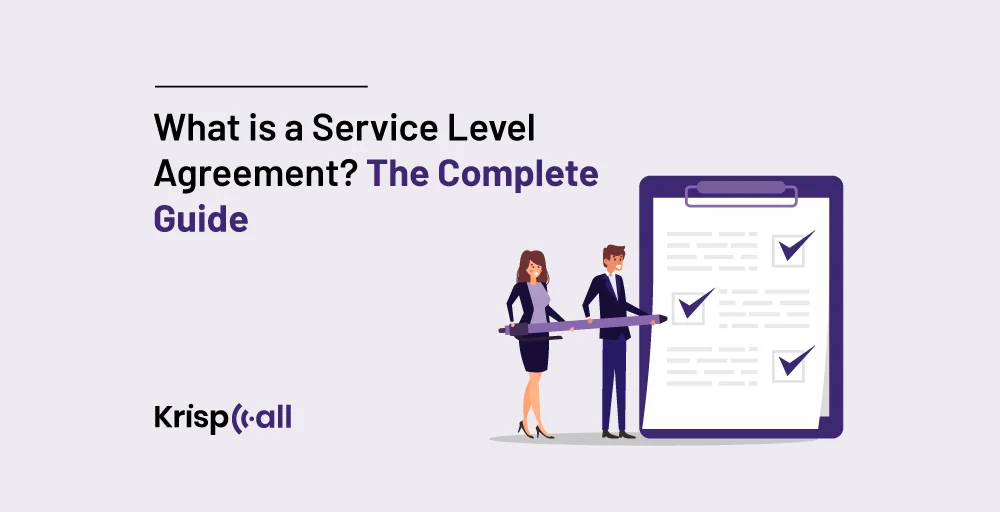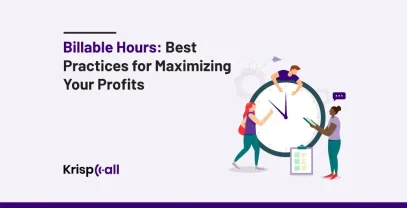A survey conducted 📝 by the National Association of State Chief Information Officers (NASCIO) states that 60 percent of state CIOs recognize SLAs as an essential part of the IT service management framework. Yet only 40 percent of the state CIOs reported having SLAs for all IT services.
A service level agreement between a service provider and a customer defines the level of service that the customer can expect. This means that service level agreements are crucial in determining the services to be offered, the aspect of responsibility, and the performance of the industries that incorporate IT suppliers, cloud computing, and internet services.
This article briefly covered the necessary information, such as a Service Level Agreement, examples, types, and what to consider when selecting metrics for your SLA.
Let’s explore the ultimate guide to Service Level Agreement within this article.
🔑 KEY HIGHLIGHTS
- SLAs specify the services, performance standards, responsibilities, and remedies for breaking the rules.
- Customer-based SLA, Service-based SLA, and Multi-level SLA are three types of service-level agreements.
- Availability, response time, capacity, accuracy, and resolution time are some SLA Performance metrics that should be monitored.
- The SLA does not have a specific revision schedule but must be reviewed regularly.
What is a Service Level Agreement?

A Service Level Agreement (SLA) is a formal contract between a service provider and a client that specifies the expected level of service and the metrics used to measure it. SLAs are critical for setting clear expectations, defining responsibilities, and ensuring accountability in service delivery.
Service Level Agreement Examples
Example: SLAs for Azure Application Insights by Microsoft.
Microsoft has separate service level agreements for each Azure service, and this SLA example demonstrates the agreement for application insights, which is included in Azure Monitor. The document’s key highlights are listed at the top, including a description of the service’s functionality, a statement of the version’s applicability, and an uptime guarantee. You will also find links to SLAs for related services that are valuable to Azure clients.
Types of Service-Level Agreements
There are three types of service-level agreements, which are described below:
1. Customer-based SLA
This type of SLA is customized to individual customers and includes all services relevant to that client under a single contract. It specifies the agreed-upon type and quality of services for that specific customer, ensuring clarity and specificity in service provision.
2. Service-based SLA
A service-based SLA is a contract that guarantees the same level of service to all customers, ensuring a consistent standard across the board. It simplifies service delivery for companies by providing a consistent service level to all end users who sign the service-based SLA.
3. Multi-level SLA
This type of SLA allows for customization based on the needs of the end-user organization and the addition of various conditions to create a more tailored service. It is divided into levels and addresses contracts at the organization’s corporate, customer, and service levels to meet specific needs.
Why are SLAs essential?
SLAs are essential for a few key reasons:
1. Clear Expectations
They set clear expectations for the service provider and the customer. Everyone knows what kind of service is provided and what quality to expect. This helps avoid misunderstandings and ensures everyone is on the same page.
2. Accountability
SLAs hold the service provider accountable for meeting performance targets. If they don’t meet these targets, there may be consequences outlined in the agreement. This motivates providers to deliver high-quality service.
3. Improved Communication
SLAs can encourage better communication between providers and customers by setting clear benchmarks. If issues arise, both parties have a clear framework for discussing them and working towards a resolution.
What are the Key Components of a Service-level Agreement?
The key components of a Service Level Agreement (SLA) are:
1. Overview of Services
You must know and have information about all the services and how they are provided, such as maintenance service, operation hours, dependencies, workflows, and technologies used.
2. Service Efficiency
A key component of a Service Level Agreement (SLA) is service efficiency, which includes performance measurement metrics and levels to measure service quality.
3. Compensation
If the provider fails to fulfill the SLA obligations, the service provider must provide liability as compensation or payment to the customer.
4. The Parties Involved
In a business, there may be two or more than two parties that are aligned. So, you must identify the contracting parties and their roles and commitments.
5. Safety
Safety is the primary concern for all business owner and their customers. Likewise, the service providers will undertake all security measures, such as IT security and nondisclosure agreements.
6. Risk Management and Disaster Recovery
The SLA also needs to define the response rules in case of an incident, the rules for data backup, and the rules for estimating the time to restore services.
7. Service Monitoring and Reporting
This section of the SLA should indicate how the provider will monitor the performance of the metrics outlined in the agreement. This may include information about what tools they use for monitoring, how frequently they collect data, what kind of reports they give to the customer, and so on.
How Can You Verify Service Levels?
Verifying an SLA involves checking if the service provider meets the agreed-upon performance metrics. Here’s a breakdown of the process:
1. Identify the Metrics
Review the SLA document to identify the specific metrics used to measure service performance. These could be internet service uptime, customer support response time, or data processing accuracy.
2. Monitoring and Reporting
Check if the SLA outlines how performance will be monitored and reported. Some providers share their own monitoring systems and reports with you.
3. Track and Analyze Data
If the SLA doesn’t have built-in monitoring, you might need to track the metrics yourself. This could involve independent monitoring tools or keeping records of service outages or support interactions.
4. Compare to Targets
Once you have performance data, compare it to the service levels specified in the SLA. This will show you if the provider is meeting the agreed-upon targets.
5. Identify Discrepancies
Note any significant discrepancies between actual performance and the SLA targets. This could be the basis for discussions with the service provider.
What Kind of SLA Performance Metrics Should Be Monitored?

SLA performance essentially connects to how well services provided by a service provider may be aligned with the definitions or expectations expressed in a service level agreement. Some of the SLA performance metrics that should be monitored include the following:
1. Availability
Service level agreements are almost impossible to implement without Service Level Commitment. It calculates the ratio between the amount of time a service or application is operating or accessible to users. High availability, therefore, means that there will be minimal or no downtime, and the users can access the service.
2. Response Time
This metric measures the speed at which the service can resolve an issue or inquiry. It measures the time between events, such as the time a support agent takes to acknowledge a customer’s message or system response to an action by a particular user.
3. Capacity
This metric refers to the preparation scale that a service provider puts in place to meet the expected demand. Load management describes the provision to regulate the utilization of the system to manage increased power demand and system overloads.
4. Accuracy
This metric focuses on the accuracy and consistency of the information or output provided by a service. The service thus becomes unreliable because users rely on incorrect information, which can harm the decision-making process and lead to resource wastage.
5. Resolution Time
It extends beyond first contact and measures the total time it takes to close a case or answer a request. It incorporates the average time an issue takes to be resolved or a task completed, including the response time.
6. Security
This metric guarantees the service is safe from breaches and cyber-attacks and maintains user privacy. Security metrics help track login attempts, suspicious activities, or other activities that might lead to a security breach and inform precautionary measures to protect sensitive information.
What are the Things to Consider While Selecting Metrics for My SLA?
There are a few things that need to be considered while selecting metrics for your SLA:
1. Align Metrics with Business Objectives
It is possible to select KPIs that relate specifically to your organization’s key objectives and initiatives. Similarly, you must validate that the metrics are appropriate and valuable to the service provider and the client.
2. Define Clear and Measurable Targets
While choosing metrics for your SLA, setting reasonable and measurable goals for each metric associated with numbers and thresholds may be helpful. The same can be true for doubtful or subjective measures.
3. Ensure Metrics Are Measurable and Verifiable
When choosing the metrics for your SLA, you must refer to those that are measurable and verifiable by both of you. It is also possible to give precise definitions and calculation methods for each metric.
4. Consider The Performance of All Involved Parties
It is also essential to consider the performance of subcontractors and third-party providers, as this might influence service provision performance. Likewise, this consideration will help you select the best metrics for your SLA.
5. Prioritize Critical Metrics
While selecting metrics for your SLA, Relevant KPIs should include a limited number of metrics that matter the most to the client and the service delivery. Likewise, do not provide the SLA with an excessive number of metrics.
6. Review and Update Metrics Regularly
It is essential to regularly evaluate and modify the metrics if they are no longer up-to-date or appropriately reflect the business goals. You can also use feedback from the cooperation to enhance the SLA continuously.
How to Write a Service-Level Agreement? 6 Steps
The steps to writing a service-level agreement are as follows:
- First, you must identify the stakeholders that require the commitment. In this case, the service provider charges the customer and the company providing the service, the Internet.
- It is essential to be clear about the service being provided to the customer. Is it repairing computers, delivering packages, or something else?
- Determine the most important issues to you, such as how long it takes to resolve the problem or how often it should be delivered.
- You should figure out if there are ways for you to measure if these expectations are met. This might be an amount of internet uptime or the percentage of on-time deliveries.
- You can also design a scenario representing the case when the service doesn’t meet the customer’s expectations. For example, you might even have the return, or they would be obligated to fix your problem faster for the following one if you have valid reasons for them.
- Lastly, the most crucial part is ensuring that everyone has read and understood it and does not contradict anyone’s or your interests.
Service Level Agreement Penalties
SLA penalties are a form of punishment used when specific terms in the SLA are not met. These penalties allow for enforcing accountability and encourage service providers to fulfill their responsibilities. Here are some common types of SLA penalties:
1. Financial Penalty
This penalty includes a financial penalty for every violation of the SLA, with some standard penalties depending on the type, severity, and/or occurrence of the problem.
Likewise, the financial penalty has a direct economic impact on poor service levels, and this can be used to ensure that the service levels are attached to them and that people are held accountable for them.
2. Service Credit
The service credit penalty imposes penalties in the form of credits or extensions on failing to meet SLA obligations, such as completing man-hours or providing services as scheduled.
This type of penalty ensures the customer’s satisfaction and that every company has a right to provide additional services or credits when it lacks one of the services offered to customers.
These penalties are a significant part of SLAs; they ensure that service-level breaches are corrected and that the level of service specified in the agreement will be fulfilled.
How Often Should You Revise Your SLA?
There is no specific revision schedule for the SLA, but it is vital to review it regularly. Likewise, things could range from service boosts to regular performance outcomes (positive or negative), trends in the area, and changing customer demands.
Reviewing performance on at least an annual basis is an excellent place to start, but any significant changes should be dealt with when they arise. Similarly, this helps ensure that your SLA is up to date and will accurately represent the service environment and expectations you are currently in.
SLA Best Practices
A service level agreement is crucial to the business, so some essential best practices for Service Level Agreements (SLAs):
- It is possible to set the SLAs by ticket type and priority to distribute the workload accordingly and inform requesters about potential delays.
- Create SLAs for response time, in which the employee must respond to a ticket, and SLAs for resolution time, in which a ticket must be fixed.
- Put tools that deal with the SLAs whenever there is a violation, such as real-time tools used to resolve issues and prevent escalations.
- Review SLAs frequently to determine the level of service desk efficiency and the overall usefulness of the SLA.
- Set realistic and service-level agreements that are manageable and practical based on resources and other business needs to prevent creating false expectations.
- Involve support agents in formulating SLAs to accurately and timely represent the client’s requirements and attain more attainable goals.
- Assess and amend SLAs regularly, taking into account developing client requirements and service expectations to keep them current and agile.
Conclusion
Finally, there is an approach of accepting and acknowledging the service level agreement as the major bridge that can be used to collaborate with the customer and the service provider in enhancing the quality of services provided. It implies clear communication and sets quality and expectations in this place.
The definition of an SLA, including its various elements and procedures for doing so, will support and enable a service-oriented relationship.
It is crucial to point out that a clearly defined SLA is a good investment that enables customers and providers to build trust and guarantee that they will not encounter any surprises from the service providers, hence encouraging them to provide the promised service.
FAQ
What do you mean by SLA earn-back provisions?
SLA earn-back provisions are like a do-over clause in a service agreement. If the provider fails to meet its targets (for example, internet uptime), it is liable for a credit (as punishment).
However, they will get their credit back by achieving the target within a stipulated period that remains in line with their passion for high standards. This motivates them to go ahead and learn, but you should ensure the rules are reasonable for both sides.
If you do not meet your agreed-upon service level, what will happen?
If you don’t meet your agreed-upon service level, this could result in fee reductions or service credits against the customer’s fees and contract termination due to repeated failures.





